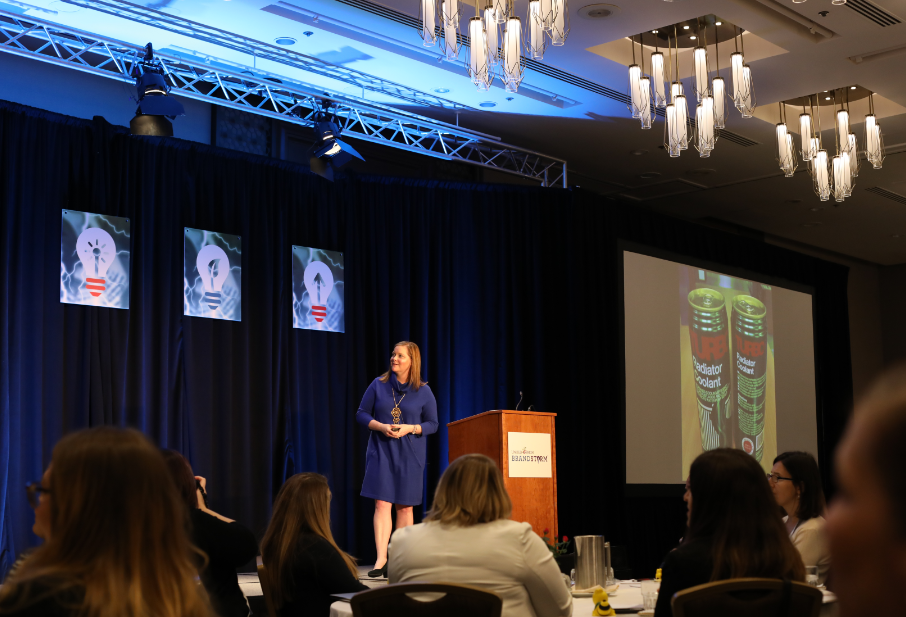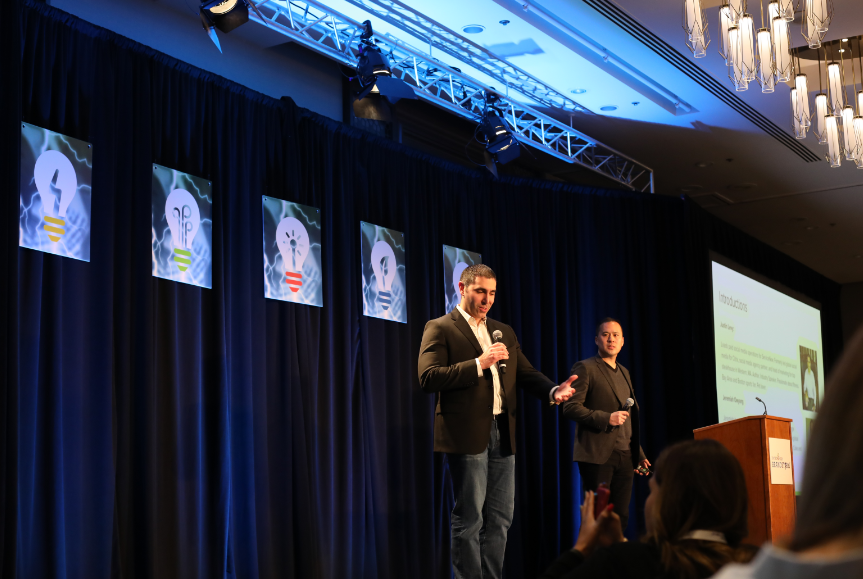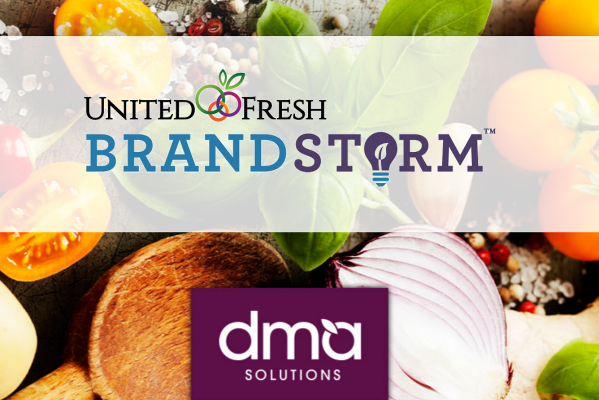Imagine you had two days to come together with other fresh produce industry marketers to focus on camaraderie, collaboration, brainstorming, and the sharing of thought-provoking ideas and challenges in a safe space, free from distraction. That, my fellow fresh produce colleagues, is what the United Fresh BrandStorm Conference is all about!
In its 4th year, BrandStorm successfully generated more collaboration and engagement amongst industry marketers than ever before. The high energy throughout the conference was particularly noticeable, and the United Fresh Staff and Marketing and Merchandising Council did a wonderful job setting the tone for the event’s collaborative atmosphere. Discussion format X-Change sessions along with the lunch time “Debate Storm” played a key role in prompting marketers from across the industry to openly discuss their challenges and potential solutions with one another in an open forum.
Four DMA team members attended this year’s conference and came home full of takeaways and thought-provoking topics that perhaps we should be exploring more together as industry marketers. Did you happen to catch our Instagram Stories highlighting key points from each Brandstorm session? If not, be sure to give us a follow at @dmasolutions so you’ll catch our coverage of the next industry event!
Here’s our take on the highlights and insights from BrandStorm 2019:
Key Takeaways from BrandStorm 2019 Sessions
Focus on seeing as your audience sees to create a more meaningful brand story
“You can’t change what people do until you change how they see.” The opening speaker, Tamsen Webster, set the stage for this year’s BrandStorm by challenging attendees to look at their approach to marketing from a different perspective. By taking the time to understand your audience, you can build a story on the wants and preferences of the individuals buying your products…rather than the wants of your marketing team.

In the Packaging Design and Shelf Appeal session, we listened to Lean Cuisine’s rebrand story, which elevated the importance of creating a meaningful emotional connection with your audience. Lean Cuisine went so far as to rebrand their products with words like “Comfort” to encourage shoppers to feel something when experiencing the brand. By making your brand experience less about you—and more about the consumer—you are increasing your value, on store shelves and beyond.
Influencers are a big part of the current fresh produce marketing conversation
It would be an understatement to say that influencer marketing is a hot topic right now, even as marketers struggle to understand how to better measure and maximize results with their influencer partnerships. Whether you are looking to grow your Instagram community, increase contacts from a promotion, or just build overall brand awareness, it’s crucial to determine goals ahead of time to know exactly how you are measuring success.
During the Influencer Marketing X-Change Session, many brands expressed a need for influencer marketing that could be done on little to no budget. While some brands have the capacity to spend top dollar on influencer work, some are working with a much smaller spend–yet looking for the same results. While the impressions numbers might not be the same, smaller influencers—often called micro-influencers—can still generate buzz around the brand that can help build a community at a lower cost. When working with these influencers, it’s important to remember that these relationships take time, so be patient and put in the work to nurture and grow ambassador programs that ultimately lead to a larger reward.
There’s never enough time to talk trends!
Elevating the ever-changing demands of consumers, whose priorities change day to day (or even meal to meal), Ed Hoffman from Padilla Food and Beverage Practice showcased a plethora of statistics around the latest trends in foodservice. Here’s a few of our favorites:
InspiRational—Consumers are looking for brands that are rational and relatable and demonstrate truth and transparency in their messaging. They want to know what their investment in a brand really means.
Customization Culture—It is no secret that everyone wants to be unique, and this applies to food choices as well. Consumers don’t want to settle for a one-size-fits-all approach.
Polyculturalism—Our ever-connected world means that audiences are increasingly looking for a fresh fusion of flavors that they’ve seen trending on social media.
Indulgent Moments—“Treat yourself” has become a common saying amongst today’s consumers. The implied health of indulgences that incorporate fresh produce provides consumers a way to treat themselves without feeling guilty.
Transparency and sustainability are in demand
Several sessions and X-change conversations touched on the growing importance of transparency and sustainability. In the Packaging Design and Shelf Appeal session, we learned that transparency can also be important when it comes to packaging. In fact, Sonoco’s Jennifer TIllman shared with us that 40% of shoppers will choose a product over its competitor solely because they can see what’s inside. Several marketers attending this session also expressed the demand for sustainable packaging, and the budget constraints limiting this innovation. We were encouraged by the case study on Daisy sour cream: their new portable, squeezable pouch, while more expensive to produce, was convenient and mess-free. Shoppers were willing to pay a premium per ounce for a solution that required less clean up and fewer utensils to use. So what can fresh produce marketers take from this? If your shoppers are telling you they want more sustainable packaging, don’t let an increased cost prevent you from meeting demand; shoppers are willing to pay the difference.

During Thursday’s Debate Storm, Jeremiah Oywang and Justin Levy challenged us to debate if we believe we should always present a polished, poised brand, or if transparency should be the guiding force behind all we do as marketers. It seemed that most groups came to the conclusion that our marketing should be a combination of a little bit of both—a layered, realistic transparency. As fresh produce marketers, we know how polarizing conversations about pesticides, GMOs, and even labor can be, and we’re challenged with providing the transparency that consumers crave without raising red flags about topics that are difficult to understand, especially for anyone without an in-depth industry and/or relevant scientific background.
In-store activity is not dead…but first, we must get people to the store
In the Retail Marketing X-change session, we discussed the importance of “the last 10 steps”—the final opportunity we have to influence and encourage a purchase decision. We heard Sunkist’s success story of the citrus experience they created in stores in target markets, a marketing action that resulted in a lift in sales. We also discussed in the Packaging Design and Shelf Appeal session that because shoppers don’t have time to determine the pros and cons of products when shopping, they often use packaging as a shortcut to making decisions. This tells us that it’s important to invest in your in-store presence, whether it be a POS display, packaging update, or sampling event. However, it’s just as important to invest in the marketing activity that affects the steps leading up to the purchase! If you aren’t driving traffic to stores to see your in-store activities, you won’t maximize your marketing investment.
Thought-provoking discussions industry marketers still need to have
Just as impactful as the key takeaways noted above are the takeaways around the conversations we’re not having, but should be. Here are a few topics we’d love to continue exploring with our fellow fresh produce marketers:
Tradeshow booths and strategies need consistent updates
Friday’s Tradeshow Experience session was a hit with its presentation of concrete examples of next-level tradeshow marketing for everyone in the room to consider. In fact, this topic could spark a debate of our own: are we doing ourselves a favor by bringing the same booth to tradeshows year after year? Just like we need to update and refresh our website and social media feeds with new content to keep shoppers coming back for more, we as marketers should also update our tradeshow booths on a more regular basis to keep buyers coming back for more. If you’ve used the same booth, recipes and strategy for 3+ years in a row now, ask yourself, are you offering your customers an experience they just have to make time to see on the busy tradeshow floor?
Fresh produce marketers must weigh the pros and cons of private label
This topic came up multiple times during debates and discussions throughout the conference: what’s a marketer to do when it comes to private label? It seems there is a wide-open opportunity here for a productive discussion amongst industry marketers around the pros, cons and challenges we all face in this arena.
In the Packaging Design and Shelf Appeal session, we listened to a case study about Tropicana’s packaging updates and learned that their “streamlined,” simple packaging looked generic to consumers. What does this tell us as marketers? That brand equity still holds value, and that today’s shoppers trust brands they love more than their “generic” and private label counterparts.
A similar challenge was echoed in the Voice Search: How to Optimize Your Brand’s Searchability session. While we can (and should) invest in search engine optimization for voice search platforms like Amazon’s Alexa and Apple’s Siri, we lose a bit of branding in the process. Sure, we can create step-by-step instructions on how to cut a mango, for instance, but how will Alexa know to tell the consumer which brand is giving them the answer to their question? And furthermore, does it even matter, as long as our efforts are increasing the demand for and consumption of the category?
Successful marketers are supported with budgets that enable activity
Budgets often are a struggle for produce marketers in terms of how to most effectively utilize existing dollars, and later, to increase available spend (and justify that additional investment). In fact, as marketers who exclusively serve the produce industry, we know that this is one of the number one pain points our fellow marketers struggle to overcome. Many marketers felt they probably couldn’t relate to examples that revolved around a spend ten times the amount of a typical produce marketer’s budget. How can we bring forward realistic speakers and examples that reflect what produce marketers CAN do with what they actually have available to spend? How can we use the success stories of “bigger” brands to ask for increased budgets to achieve our goals?
Produce companies know what it’s like to take risks, but when it comes to marketing, are we risk-averse?
There was a theme that emerged during several of the presentations: the most successful and innovative marketers are the ones who are always looking ahead and willing to take more risks. Yet many produce marketers feel that due to budget or leadership constraints, they are unable to take risks or change their mindset to a more forward-thinking, entrepreneurial one that is willing to “try and fail and try again.” In the produce industry, it’s ironic that the perishable and unpredictable nature of what we do presents risks that produce leaders are willing to take, yet when it comes to marketing, the mindset is to play it safe—don’t try it if we don’t know what to expect. Could this mindset be holding our industry back from reaching our true potential? What if we adopted the mindset of venture capitalists and said “what if?” We’d love to see this debate and discussion presented at a future BrandStorm Conference!
Now what?
So now that we’re all inspired with new and expanded marketing ideas…what happens when you come back to the office and face the challenge that comes with working to implement new practices and objectives? If you attended BrandStorm and you had an extra $5,000-$10,000 to spend to implement takeaways from the conference, what would you do?
Consider the possibility that you could:
- Create new shareable video content focused on the value you bring to consumers.
- Launch a new packaging exploratory project to discover the possibilities.
- Run a social media or Google advertising campaign to gain a better understanding of your audience’s preferences.
- Use the foodservice trends (along with Food Trends 2019!) to develop new recipes and helpful content for your customers.
- Execute a sampling event or in-store display to generate shopper interest and sales lift.
- Develop a new tradeshow booth or experience for 2019 that will wow your buyers.
- Try something completely new, uncharted or even (reasonably) risky, just to see what it does for your brand.
We can say with certainty that the DMA Team is committed to developing our own plan to capitalize on the ideas, practices, and inspiration we discovered at Brandstorm 2019. We encourage every marketer who attended to do the same—and to let us know the results! Leave us a comment below, or tweet to us at @TheCoreBlog!
{{cta(‘bcd8a198-582f-4f95-bbc3-fd4254518f02’)}}












